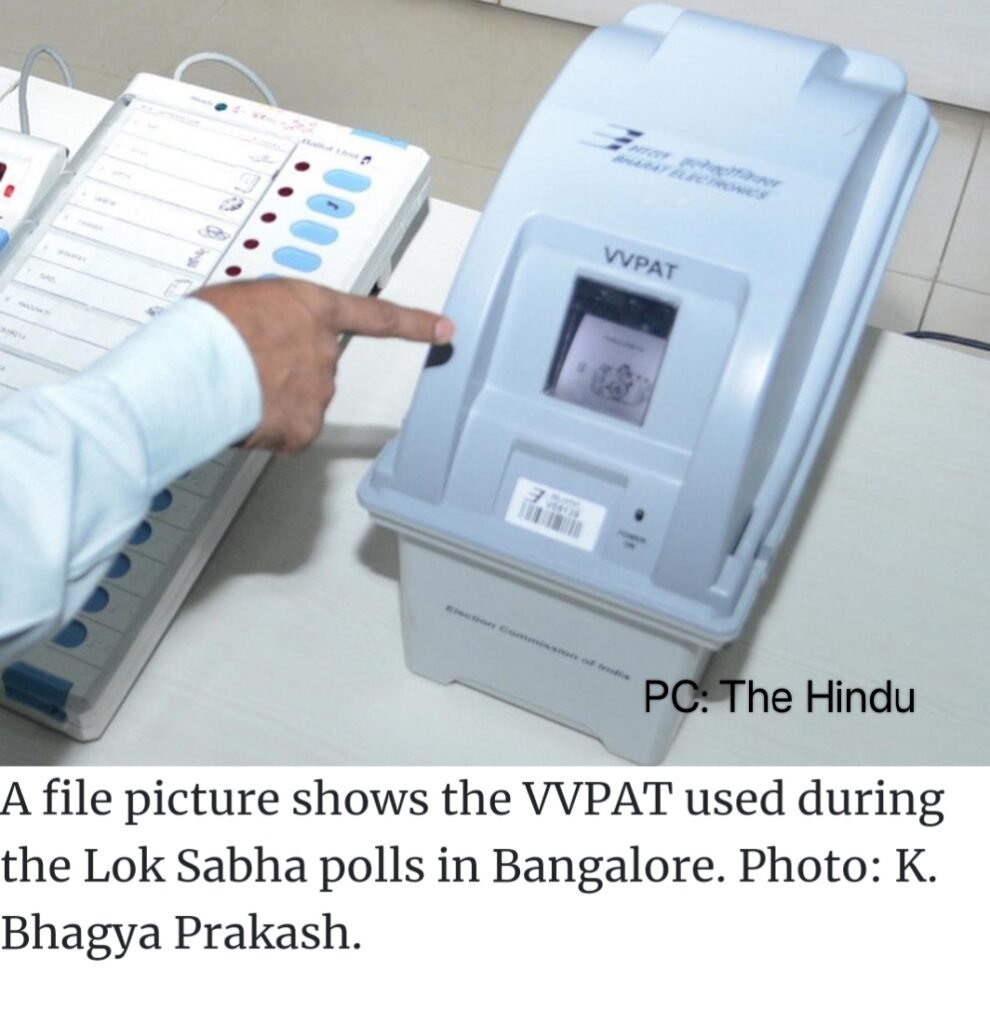Introduced in 2013, the Voter Verified Paper Audit Trail (VVPAT) is an autonomous vote verification mechanism. It promotes electoral transparency by enabling voters to confirm that their votes were accurately recorded.
VVPAT in a nutshell: A VVPAT device, linked to an Electronic Voting Machine (EVM), produces a paper slip that the voter can observe for seven seconds before it is deposited into a sealed container. This slip displays a serial number, the name of the chosen candidate, and their party symbol. In case of any contention, this container can be opened to verify the votes. Interesting fact, VVPATs with EVMs were used for the first time in a bye-election from 51-Noksen Assembly Constituency of Nagaland.
At present, VVPAT verification is required in five polling stations chosen at random within each constituency. In March 2023, the Association for Democratic Reforms (ADR) submitted a Public Interest Litigation (PIL) to the Supreme Court, arguing that the existing system was inadequate. The petition additionally requests the Court to affirm that each voter possesses an essential right to ensure their vote is “recorded as cast” and “counted as recorded.” In support of this, they propose that voters should personally place the VVPAT slips into a sealed box.
Association for Democratic Reforms, represented through their Advocate Prashant Bhushan, contended that the existing VVPAT verification process, which mandates checks in just five randomly chosen polling stations per constituency, was inadequate. To improve voter trust, he recommended reinstating the paper ballot system, pointing to its implementation in European nations, particularly Germany. Nevertheless, the judges dismissed this suggestion, highlighting the significant population disparity between India and European countries.
The Election Commission of India (ECI) explained in its reply that choosing VVPATs from five randomly selected polling stations per Assembly segment resulted in a total of 20,600 EVM-VVPAT systems, which is much higher than the 479 systems suggested by the Indian Statistical Institute. Moreover, they noted that no discrepancies were found in EVMs despite verifying 38,156 VVPATs during Lok Sabha and Assembly elections. They did mention, however, that human errors like not deleting mock poll votes could cause discrepancies. The ECI also warned against 100% verification due to logistical issues and the possibility of human error. Additionally, it pointed out that making last-minute protocol changes could pose technical difficulties for the Commission, owing to the preparations for the 2024 Lok Sabha Elections at the time.
Previous Decisions On VVPAT Voter Verification
In Subramanian Swamy v Union of India (2013), the Court determined that VVPAT paper trails were crucial for the election process. They emphasized that a “paper trail” is essential for ensuring free and fair elections, as voter trust in the EVMs depends on the introduction of this system. EVMs equipped with VVPAT systems are vital for maintaining the accuracy of the voting process. To ensure full transparency and restore voter confidence, the Court stated that EVMs with VVPAT systems are necessary since votes are a critical form of expression in a democracy. Following this case, the ECI created a manual for EVMs and VVPATs, which included Regulation 16.6 mandating that one randomly selected polling station in each Assembly Segment or Constituency must verify VVPAT slips. Nearly seven years later, in N Chandrababu Naidu v Union of India (2019), the Court increased the mandatory VVPAT verification to five polling booths per Assembly Segment.
In the case of Kamal Nath v. Election Commission of India and Others (2019), the Court acknowledged the Election Commission of India’s established reputation as an impartial constitutional authority over many decades. The Court emphasized the ECI’s commitment to conducting fair elections, which are crucially trusted by the people of the nation. Despite the challenge regarding Electronic Voting Machines (EVMs) and the request for random VVPAT verification of 10% of the votes, the Court dismissed the petition.
In the 2024 ADR case, the Court noted it could have dismissed the current writ petitions based on established precedents that were deemed clear and well-founded, dismissing challenges lacking substantial evidence as unwarranted and detrimental. However, the Court chose instead to document the electoral process safeguards implemented by the ECI to uphold fair elections and electoral integrity, specifically detailing the features of EVMs.
ADR initially brought its case before a Division Bench headed by Justice Khanna in July 2023. Despite their efforts, the Bench declined to prioritize an urgent hearing for the case. After several months of uncertainty, Justices Khanna and Dipankar Datta convened to hear the case on its merits on April 16, 2024, just ahead of the first phase of the 2024 General Elections.
Subsequently, on April 26, 2024, the Bench unanimously dismissed ADR’s request for a 100 percent VVPAT verification of EVM votes. Justice Khanna issued two directives in the ruling: firstly, he mandated that the VVPAT symbol loading units be securely sealed and stored for 45 days post-election results. Secondly, he ordered that in case of any dispute, engineers from the EVM manufacturing company should inspect the semi-controller’s burnt memory in 5% of the EVMs per constituency. Should evidence of tampering be discovered as suspected, a corresponding refund would be due to them.
Authors: Lokesh Kansal & Malabika Boruah
Read our other election related articles here:
Legislative Immunity For Lawmakers In Bribery Cases

